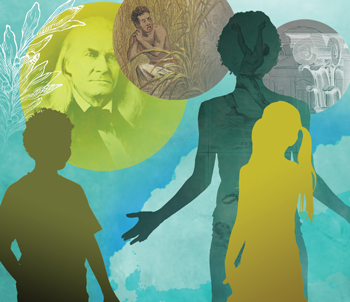Every school year, busloads of children visit estates, botanical gardens and Colonial homes in the North and old farms in the South. In almost all cases, the presence of enslaved people has left its mark: in hand-built bricks still pocked with fingerprints; in centuries of tilled, still-fertile soil; in the grains of hand-carved furniture and the seams of hand-sewn fabrics that have stood the test of time.
But, while their stories remain inextricably woven into the setting, too often enslaved craftspeople, farmers and artists aren’t named or mentioned at all by tour guides. Brochures fail to mention that, beneath the earth and behind the walls that encase these historic sites, truth has left its mark. Black students and their families sense the erasure; they feel pain where a guide presents charm and beauty. In describing how it felt to see her first-grader participate in a whitewashed plantation tour, writer Taylor Harris put it like this: “Where some people see beautiful gardens and trees, I cannot help but see the strange fruit hanging from them.”
Educators planning field trips or hoping to provide their students with an evocative, thorough understanding of local history have options—but they need to know what to look for. Kristin L. Gallas—who co-edited Interpreting Slavery at Museums and Historic Sites and is working on a second book about interpreting that history for young people—says teachers should visit sites ahead of time and look for evidence of some basic principles.
Ideally, sites should “understand how to put enslaved people and the institution of slavery in context, how to humanize people whose humanity was stripped away and how to create an empathetic bridge between us today and the individuals who were enslaved,” Gallas says.
Screening for these principles in advance of a visit can provide a guide for educators navigating field trips to historic sites.
Principle 1
Build a Knowledgeable, Responsive Staff
“A site is only as good as their frontline staff,” Gallas says. “And if the frontline staff is giving a tour that you don’t feel is good enough for general public visitors, it’s probably an indication of what their education programs are like.”
According to Ibrahima Seck, the academic and research director at Whitney Plantation, this is the key to a transformative experience for student visitors. A script will only get tour guides so far; young people will have questions and feel personal connections to what they see. He has seen how this can go wrong at other plantations and sites.
“The tour guides, they get questions,” Seck says. “They aren’t ready to answer those questions. They are in trouble. There’s a lot of embarrassment.”
So at Whitney, knowledgeable tour guides are a priority, Seck says. And he sees the results of that focus.
“Whenever I see all the tours coming back with their tour guides … there is something positive they got from it,” he says. “They don’t come back angry. They come back educated.”
A good staff will also be responsive and adapt tours and educational experiences based on the needs of the educator and their students.
“As the director of education at a historic site myself, I want teachers to come to me and say, ‘Look, we’re studying this content—can you focus a little more on this?’” says Gallas, who serves as the co-founder of Interpreting Slavery, a public education project that offers workshops for museums and historic sites. “If they’re not doing what you were hoping they would do,” she tells educators, “offer to help them.”
Principle 2
Provide the Context Behind the “Beauty”
“If you’d come to Monticello about 25 years ago, you might not even have heard anything about slavery,” says Melanie Bowyer, the manager of digital learning at the site of Thomas Jefferson’s Virginia home.
That has changed in recent years, with Monticello’s efforts to make the experience of enslaved people more visible at their site, from a new exhibit on Sally Hemings to relaying a deeper understanding of the ways in which Jefferson’s success relied on unpaid, enslaved labor.
“If we’re onsite with teachers and students, you could see Monticello and it looks like a beautiful, serene architectural masterpiece,” Bowyer says. But she stresses the importance of showing teachers and students that enslaved people touched every aspect of life on Jefferson’s plantation—the cooking, the clothing, even the nails made by teenage boys and hammered into fences and walls.
“Jefferson’s entire life was made possible by slavery,” Bowyer says, noting that the time Jefferson had to write, to think and to draft architecture was time he owed to the 100 or more enslaved people performing forced labor on his property at any given time.
In their book Interpreting Slavery at Museums and Historic Sites, Gallas and co-editor James DeWolf Perry encourage sites to teach “comprehensive content”: crafting a narrative that explores the role slavery played on a site, as well as putting it in context of the community, colony or state, nation and the Atlantic world.
Taking students to a site that doesn’t do this, Bowyer argues, is harmful—especially to black students.
“When you erase an entire population or entire group of people from the history, you’re doing a great disservice,” she says. “You’re saying that this history of African Americans did not matter. It wasn’t important. They’re not going to see themselves in this history. And they should.”
Educators should look, instead, for sites where that story of slavery is interwoven throughout—where that story is told through individual narratives that provide a more human portrait of enslaved people’s experiences.
Principle 3
Humanize the Experiences of Enslaved People
In the cellar of James Madison’s Montpelier, visitors view a film called Fate in the Balance. They hear the story of Ellen Stewart, who at 15 watched as her family was sold away person by person before she attempted to escape. During one such viewing, a child was crying. His grandmother asked him, “What’s wrong? Didn’t you study slavery in school?”
“Yes, Grandma,” he replied. “But I never knew they had names.”
Christian Cotz recalls this scene as he underscores the importance of promoting empathy by telling enslaved people’s personal stories. Cotz serves as the director of education and visitor engagement at Montpelier, where the descendant community inspired that focus on humanized storytelling.
“The real atrocities of slavery are individual and deeply personal,” Cotz explains. “By leaving them out, you don’t really convey the true history to the visitor, and you don’t give them a sense of the horror.”
At Montpelier, this is achieved through oral histories from enslaved people’s descendants, historic letters and artifacts that belonged to enslaved people, illustrating their ambitions and traditions, as well as the work they were forced to do.
Educators should seek out sites that weave these personal stories and names into the experience.
“These enslaved people were working within this horrible, oppressive establishment to make lives for themselves and their family,” Bowyer explains. These acts of agency and courage should be the highlights of any trip to one of these sites—or to any teaching about slavery.
Principle 4
Include Descendant Communities and Personal Narratives
In a rubric of best practices for engaging descendant communities established by the National Summit on Teaching Slavery, the authors do not mince words in underscoring why it matters: “Without their voices, our research lacks depth, humanity and credibility, and institutions continue to perpetuate the exploitative practices of the past by privileging the perspectives of slave owners.”
This is why Kyle Stetz, the manager of student and family programs at Montpelier, says the first question an educator should ask about a historic site is, “Where is the story that they’re telling coming from?”
Stetz cites this as one of Montpelier’s strengths, where descendant families lend their voices to oral histories heard by visitors and to decision-making discussions by the institution itself.
“We would not have been able to do this exhibition without two decades of relationship building with the descendant community,” Cotz says. “Telling personal stories in a very empathetic and humanistic way was important to them.”
Much of what the Montpelier descendant community produces—from genealogical research to archaeology expeditions to inherited stories and artifacts—is also being produced by descendant communities at other sites across the country. Educators should let that work inform units and trips surrounding the topics of slavery or early America.
Principle 5
Connect Past to Present

“We can’t understand Black Lives Matter without understanding the history of slavery,” Gallas says. “We can’t help kids, especially children of color, understand all the different types of racism in our country today without understanding where that came from and how the construction of race and its connection to slavery existed for so long.”
At Montpelier, Christian Cotz sees the strongest reaction—both positive and negative—to their 10-minute video, The Legacy of Slavery.
“I think [some] people don’t want to think about James Madison and Black Lives Matter or the Charleston shooting in the same breath, in the same space,” Cotz says.
These experts embrace that discomfort and continue to connect past and present in their exhibits because they know it’s necessary for a thorough history education.
“When I say visitors get transformed,” Whitney’s Ibrahima Seck says, “I mean they finally have a material understanding about the legacy of slavery.”
That material understanding is key, Seck and others say, not only to inform young people about why things are the way they are, but to arm them with the information to talk about it—and to do something about it.
At Whitney Plantation, Monticello and Montpelier, the past-to-present through-lines are explicitly documented in exhibits, videos and online educational resources. Sites like Cincinnati’s National Underground Railroad Freedom Center and Philadelphia’s Cliveden historic house have made community action and conversations about present-day inequalities part of their programming.
“It’s important in not just defining where we started as a nation but defining where we are today … especially for teachers,” says Monticello’s Melanie Bowyer. “I think they’re the ones that can really make a difference.”
History hides behind facades, but teachers don’t have to. They hold the tools needed to expose students to honest interpretations of history—and to respect the people who lived that history by saying their names.
Collins is the senior writer for Teaching Tolerance.
Making Your Classroom the Historic Site
Funding, geography or lack of institutional support may prevent educators from taking students to an exemplary historic site—but you can still bring the best practices of historic sites into your classroom.
Be knowledgeable and responsive. Always be willing to further educate yourself on the history of American slavery so you can be ready to answer your students’ questions. A book like Understanding and Teaching American Slavery is a good place to start.
Provide context. Avoid what Christian Cotz calls “the mythology of America,” which tends to center the Founding Fathers as visionaries beyond reproach. Telling everybody’s story means always providing context as to what privileges allowed certain people to succeed, what forces held other people down, and how slavery contributed to the political and economic development of early America.
Humanize the experience of enslaved people. Utilize primary sources and artifacts to illustrate the many deeply personal ways that slavery affected them.
Listen to descendant communities. Collaborate with local descendant communities to see if they’d be willing to share their stories. Even if you cannot invite members of a descendant community into your classroom, you can still highlight their stories.
Connect past to present. Teach the through-lines and the legacy of slavery. From convict leasing to Jim Crow laws to mass incarceration to ongoing racial inequities in U.S. institutions today, challenge students to think like historians and help them draw connections.

